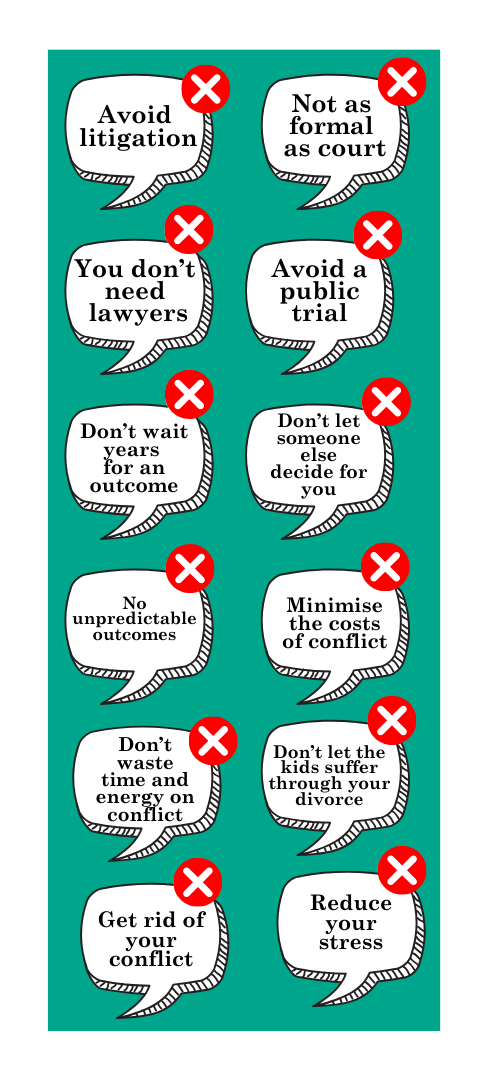When we look at how people typically promote conflict-related services like mediation, the services are often presented as a better option than other alternatives. In fact, this thinking is even found in the name “alternative dispute resolution”.

However, psychological research shows that using scare tactics to try to motivate someone to do something tends not to work. This can be explained by what Wayne Hershberger (1986) first called “the law of approach and avoidance”. This means that we tend to move towards pleasure and away from pain.
While you might think that telling someone about all the bad things that might happen if they leave their conflict unresolved would motivate them to move away from those bad things towards something better (e.g. mediation), the problem is that we have promoted our service by reference to the bad things, so they may well subconsciously move away from us!
When we feel an emotion that we find unpleasant, our brain’s natural response is to move away from the thing related to that emotion. In contrast, when we feel an emotion that we find pleasant, our brain is wired to approach.
However, in her book The Influential Mind, Shari Talbot explains that when we are trying to influence someone to do something, we have to be careful how we apply this logic. While we tend to move away from something that we see as unpleasant, we can also stop moving altogether if we are not sure about what we are moving towards.

Our brains are wired so that anticipating a reward not only triggers approach, it is more likely to elicit action altogether. If you want someone to act quickly, promising a reward that elicits an anticipation of pleasure may be better than threatening them with a punishment that elicits an anticipation of pain.
In short – if we are trying avoid something bad, we may move away from it, but we may also freeze if we are uncertain about what lies ahead of us. In contrast, if we know that something positive and rewarding lies ahead of us, we are more likely to actively take steps towards that better option.
This works for both words and images.
A study of crowd funding requests, carried out by Alexander Genevsky and Brian Knutson from Stanford University examined 13,500 online requests for funding. These requests were often for financial support for people needing expensive medical treatment. Counter-intuitively, the research found that crowd funding requests were more likely to raise money if they showed someone happy and well, rather than someone sick in a hospital bed.
If you search online stock photo libraries for photos relating to “conflict resolution”, you will perhaps be surprised to find that many of the images do not illustrate “resolution” but rather show people in conflict.
Here are some examples:

As well as the law of approach and avoidance, we need to consider people’s need for a sense of certainty and control.
Warnings and threats limit people’s sense of control, so instead we need to emphasize what needs to be done to reap rewards – which increases their sense of control.
So, what does this mean for marketing a service like mediation?
Firstly, talk about the benefits that clients will achieve by participating using an approach framework. Don’t just talk about the bad things they will avoid; also talk about the good things they will gain so that they can manage risk and also know what they can work towards.
Secondly, emphasise the client’s opportunities to make choices and take control of their future.
Thirdly, use positive images on your website, that show how people will feel and behave after they have used your services.
Here are some examples:


Review your website and promotional materials. How much of your content is about what clients can AVOID by engaging your services? How much of your content is about what clients can GAIN (rewards, pleasure) by engaging your services?
What kinds of images do you use? Do they show the problem a client wants solved, or do they show how the client will feel after they work with you?
What ideas do you have to describe the outcomes that people gain from working with you that elicit positive emotions?
Want to know more about how to develop and market your practice?
If you have been thinking about registering for the Beyond the Table course, now is the time. Our special BETA testing rate ends on 30 June and the price doubles on 1 July 2024 (mind you, this is still a bargain for the value in the course)!
As well as the terrific content, workbooks to apply your learning to your business right away, access to over 20 terrific guest presenters, and bi-monthly live Business Brainstorming sessions, you will meet a group of fellow students who are providing peer support and networking opportunities to each other. It takes a village, so come and be a part of ours!
If you are serious about developing your practice into a thriving business, register now: https://conflictmanagementacademy.com/beyond-the-table-course


Tali Sharot, The Influential Mind: What the Brain Reveals About Our Power to Change Others (2017).
